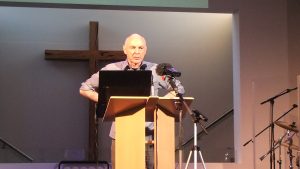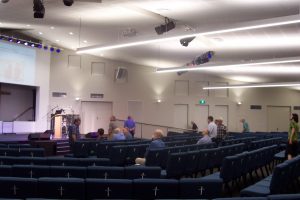Meeting Report
What Did They Say?
Maintaining Voice Intelligibility in Difficult Acoustic Environments
On Monday February 27th keen AES Melbourne members and guests travelled to the outer eastern suburbs to the Kilsyth South Baptist Church to see their installation of Quest amplifiers and speakers and to hear Quests’ Frank Andrewartha speak on the topic “Maintaining Voice Intelligibility in Difficult Acoustic Environments”

Frank started out by explaining that he would look at different ways of approaching challenging acoustic situations, because there is no “one size fits all” solution.
He then went on to look at measurement systems, and covered the history behind measuring speech intelligibility – covering STI (Speech Transmission Index), Alcons (Articulation Loss of Consonants), and C50, and the hardware used to make the measurements.
He then spoke on the influence of reverberation on speech intelligibility, and covered early auditorium/amphitheatre design, particularly the Greek and Roman public spaces.
He then mentioned the first published work which focused on acoustics – Magiae Universalis by Gaspare P Schotto in 1657. It covered reflections and sound wave behaviour as a largely geometric problem.
Frank then moved on to modern sound reinforcement, citing the 1915 US presidential inauguration coverage, and then on to the cinema with the advent of “talkies”.
Then to the present era, Frank went on to describe the line array – calling it a specific tool to provide solution to a specific problem -especially with the predictive software that allows designs to be modelled.
After a quick explanation of Inverse square law, he then went on to show that with multiple speaker boxes tangential waves cause an interference effect (comb filtering )- presenting an analogy to the difference in the wave patterns caused by throwing a brick into a pond (even waves – uniform energy dissipation) versus throwing a handful of gravel (disturbed wave flow).
Returning to the line array, he explained that it creates a cylindrical waveform as opposed to a spherical waveform. By stacking sound sources on top of each other he said that the source of the wave is emanating from a line source instead of a point source.
He then covered issues with a line array – Firstly, a real line source line array has to be a certain length before it’s going to be a real line array, secondly, it has to be non-tangential across the whole frequency spectrum it’s projecting.
He posited that a reasonable approximation of a “cylindrical wave front” requires a line height of about 4x the wavelength. So for 50 Hz, that meant a 26.6m tall line.
He then described what he called the first really practical linear array, the L-Acoustics V-DOSC array, and modelling software.
He then covered the reasoning behind the J-Shaped array and angular shading (amplitude shading) and then described the Nexo Geo tangent array.
Having comprehensively described the line array he moved to the use of loudspeaker delay systems.
Following this he spoke of Quest’s approach, where they treated the problem of intelligibility as an energy distribution problem, not an audio quality problem.
He presented point source distribution, where there could be control over where the sound went without having to use electronics – provided the problems of the lobing could be dealt with, the tangential waves controlled, and the energy kept focused. All of this to be in an arrayable system that could be bolted together by anyone.
He described the years of R&D undertaken by Quest to this end, and the operation of their asymmetrical waveguide which realised these goals.
He then played audio examples, demonstrating the challenges of achieving audio intelligibility in demanding circumstances, such as the presence of reverberation. The audience was then able to evaluate the intelligibility of the installed system throughout the room via the playback of spoken word excerpts.

Frank then pointed out that his asymmetrical projection does throw down as well as out, and having the energy dissipated over a much wider area means that it is pretty reluctant to feed back, because of the lack of a “hot zone” at stage level, in fact the “hot zone” is beaming over the people’s heads.
He concluded by saying that their approaching it as an acoustic energy management problem meant that a whole lot of the sound spectral problems basically went away.
The evening concluded with a Q&A, where a range of loudspeaker and sound reinforcement issues were canvassed.
A video has been assembled of the talk, covering the Powerpoint slides+audio:
This video can also be viewed directly on YouTube at:
https://www.youtube.com/watch?v=OUwq4bRxTWE
A PDF copy of the slides presented can be viewed or downloaded here.
and
The audio-only recording can be heard or downloaded here.
Thanks to Graham Haynes and his trusty Tascam for the audio recording.
A special thanks to the Kilsyth South Baptist Church for hosting the night, and to their members helping on the night.
